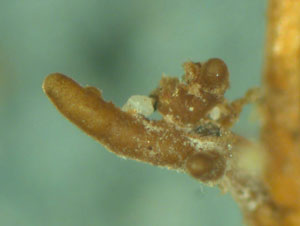The symbiotic fungus Tuber melanosporum Vittad. (Perigord Black truffle) belongs to the Ascomycota (Pezizomycota, Pezizomycetes, Pezizales, Tuberaceae).
|
|
This soil fungus is endemic to calcareous soils in southern Europe and induces a beneficial ectomycorrhizal symbiosis on haselnut tree and oaks. The fungus requires a host tree to complete its life cycle and produce hypogeous fruit bodies, so-called truffles. The Perigord Black truffle is a highly appreciated delicacy for its delicate organoleptic properties (i.e., taste and perfumes). This is a 'national, cult-food', one of the worldwide recognized icone of the European gastronomy and culture, for which genomic information could act as a knowledge platform to improve its production and environmental persistence.
|
| The ectomycorrhizal symbiosis and the truffle life cycle In the ectomycorrhizal symbiotic relationship, long, branching fungal filaments known as hyphae ramify between cells of the host root’s outer layers, form a sheath around the root, and radiate outwards into the surrounding soil and litter. In late Summer, extramatrical hyphae aggregate to form fruit body initials. The latter developed to the fruit body during Fall and early Winter. The spores released from mature truffles germinate in the following Spring, producing a vegetative mycelium, which results in colonisation of tree root tips and further development of the symbiosis completing the truffle life cycle.
| 
|
Understanding the evolution of symbiosis in fungi
Besides one of the two symbiotic fungi thus far addressed by a genomic project, T. melanosporum is the first sequenced member of the Pezizales, a very large and heterogenous group of ascomycetous fungi presently devoid of any genomic coverage. There is currently debate about whether most ectomycorrhizal fungi are derived from a few ectomycorrhizal ancestors, with multiple losses of that lifestyle in many currently saprobic lineages, or whether the pattern is based strictly on many convergent gains of the mycorrhizal habit with no reversions to saprotrophy. The genome architectures of symbiotic fungi may bear tell-tale signs of their adaptation to the symbiotic lifestyle. To assess whether independent symbiosis events result in similar genomic signatures, we have sequenced the genome of T. melanosporum and compared it to the genome of the symbiotic basidiomycete Laccaria bicolor.
The French-Italian Tuber Genome Consortium
Following an initiative of the "Tree-Microbe Interactions" Unit at the INRA Center in Nancy, the Scientific Council of Genoscope formally approved the genome sequencing of the T. melanosporum in 2005.
A consortium of 10 French and Italian laboratories, including the INRA-Nancy, the Università degli studi di Parma, Istituto per la Protezione delle Piante del CNR di Torino, Istituto di Genetica Vegetale di Perugia and the Università degli Studi di Urbino, was formed to annotate and analyze the genome.